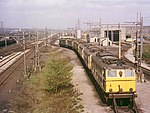Wath (Hull and Barnsley) railway station

Wath railway station was one of three railway stations in Wath-upon-Dearne, South Yorkshire, England. It was the southern terminus of The Hull & South Yorkshire Extension Railway which became part of the Hull and Barnsley Railway in 1898 and was the southern terminus of a branch line from Wrangbrook Junction. The station was located on Station Road between the Great Central Railway's Wath Central station and the Midland Railway's Wath North station. Branch line trains connected with Sheffield-Cudworth-Hull trains at Wrangbrook. The railway was opened for passengers on 28 August 1902, with Wath being 8 miles (13 km) from Wrangbrook Junction and 11 miles (18 km) from Kirk Smeaton, where the passenger service went to. However, the line was not a success for passenger traffic: it was closed to passengers on 6 April 1929. The station at Wath was a single platform affair but with a substantial station house. This and the former ticket office are the only surviving remains of the station and have survived the buildings of Wath's other two, more successful stations: they still stand on Station Road, called "Station House" and "Barnsley Cottage" respectively.
Excerpt from the Wikipedia article Wath (Hull and Barnsley) railway station (License: CC BY-SA 3.0, Authors, Images).Wath (Hull and Barnsley) railway station
Station Road,
Geographical coordinates (GPS) Address External links Nearby Places Show on map
Geographical coordinates (GPS)
| Latitude | Longitude |
|---|---|
| N 53.507484 ° | E -1.337388 ° |
Address
Wath (Hull and Barnsley)
Station Road
S63 7DQ
England, United Kingdom
Open on Google Maps







